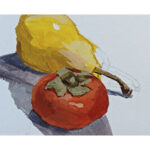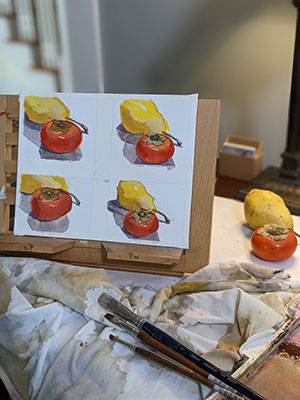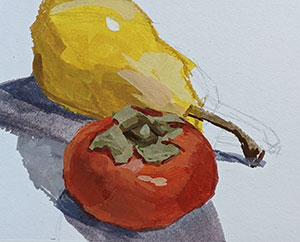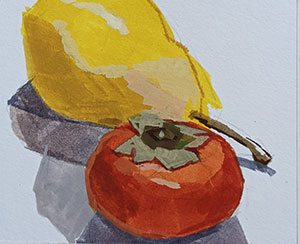Part Two Pear and Persimmon Painting

Well here we are with Part Two Pear and Persimmon Painting. Why Part Two? Well because I painted four of these little 3×4 inch paintings in gouache. There are some fun distinctions within each of these paintings that I hope to share with you this week. But before I do, here’s a warm welcome to new and returning readers. And, for those who are new, here’s a link with a description of the purpose of this post and blog.
Four Paintings
Here’s a picture of all four paintings at their finished stage. I am sharing this so you can see them all together and perhaps distinguish them.

The two that are ‘new’ this week are in the right hand column. With each of these paintings I was mindful of how to paint as much with as few marks as possible. And, I decided not to apply paint across the entire surface. The fun part about this is that you can see some of the pencil marks of the drawing I did before painting.
To me, there is an indescribable delight to seeing drawing marks, the canvas or even marks of other tools or the underpainting of a painting.
An Art History Example
Here’s a fun example of a surprise in a painting. If you ever have the chance to see John Singer Sargent’s “Smoke of Ambergris” painting, in person, go! Why? Someone told me he used a compass to create the beautiful shawl over the woman’s head and face. I had to wait while others looked closely at this painting. But! I finally got close enough to see it. See what? The teeny tiny pin prick of a hole in the surface where he must have used the compass. Ever since then, I have looked at paintings in the hopes of seeing the artist’s lines, brush strokes and any other surprises.
Pear and Persimmon Painting 4
Here you can take a look at the pencil marks of this painting. And, well, the corrections too. How fun is that? Incidentally, there’s a word for this. For what? When you can see an artist’s revision on a painting it’s called pentimento. Isn’t that a beautiful word? As I think of it, pentimento would probably not apply to the compass mark on Sargent’s paintings. But there are plenty of other renowned drawings and paintings in art history where you can see marks and corrections.

And, there are some in Pear and Persimmon 3 as well. See?

Looking at these marks in these paintings reminds that, in fact, the steps we take in drawing and painting are really a series of corrections. This is helpful to remember as I work on a new painting or drawing. This point of view might even be helpful as we navigate this crazy world in which we live too. Kind of a forgiving acknowledgement of mistakes and corrections along the way.
Confession
So while we are in the midst of forgiveness, gentle reader, I had hoped to have all four of these sweet paintings matted and framed. But we are away camping at Hunting Island South Carolina right now. And, I did not finish the matting or framing yet. I apologize! But, if any of these paintings interest you as a present, please contact me here. We can figure out how to get these ready for you before the Holiday Season arrives.
How About You
How about you gentle reader? Have you had to make some corrections or ask forgiveness recently? If so, join the club and forgive yourself. And, feel free to share in the comments below!

4 Comments
Denise B Todloski
November 17, 2022Elegant and eloquent as always, Julie, I enjoy your work and your musings. : ) xx
Julie Holmes
November 23, 2022Thank you so much Denise!!! It’s so great to hear from youuuu! xx and 😉 back to you!!!
Beth Clary
November 17, 2022Very interesting and informative post, Julie. You’ve helped me expand my vocabulary and I am perpetually awed by all you have to do to create a painting! And these paintings are such interesting and unusual colors. Love that and am curious what those colors’ names are.
Julie Holmes
November 23, 2022Thank you Beth!!! Actually – the colors are mixed from the three primaries: red, yellow, blue and white! That’s it! Isn’t that crazy? Thanks so much for reading and commenting here! xoxo